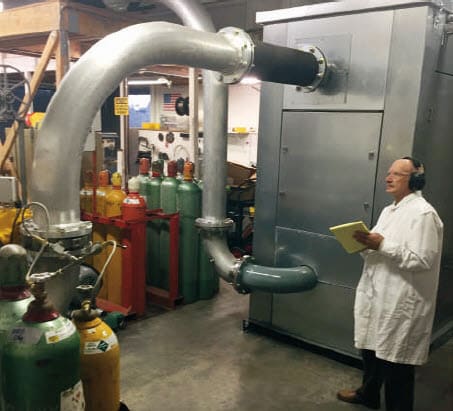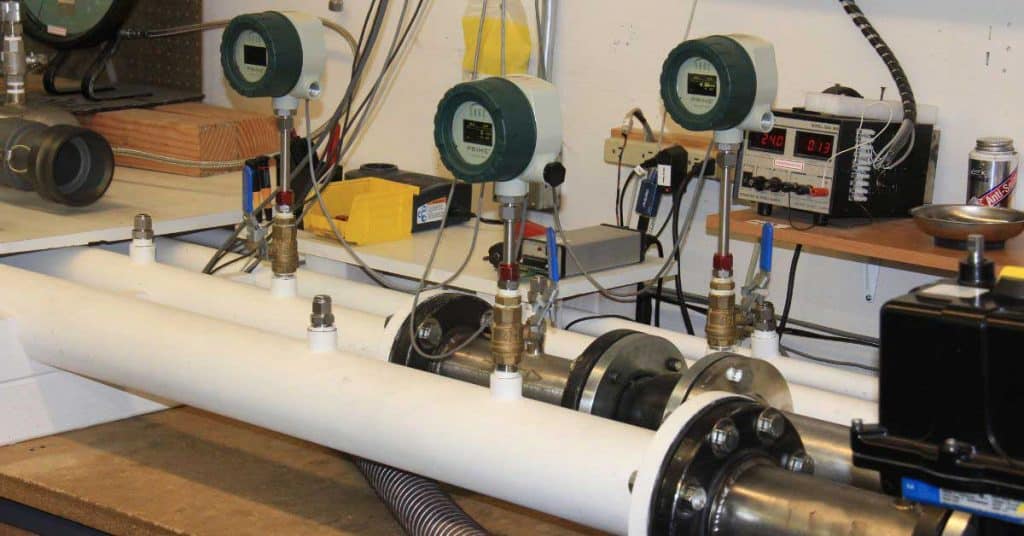A thermal mass flow meter calibration is the foundation for accurate gas mass flow measurements. Without calibration, the meter readings are suspect. The flow meters are calibrated during manufacturing, and most manufacturers recommend that their meters be returned to the factory annually for re-calibration.
Thermal Mass Flow Flow Meter Calibration Basics
Once a manufacturer produces a meter, it must be calibrated before it is sent to the end user. The meter’s calibration ensures that any thermal mass flow meter measures correctly. Sage Metering calibrates its thermal mass flow meters in its NIST Traceable calibration facility.
The flow rate measured by the thermal flow meter is an inferred measurement. The instrument measures the power required to maintain the desired overheat temperature of the heated sensor above the reference sensor. This relationship between power and mass flow rate is established during the calibration. While considerable effort is made in designing and building the sensors, each sensor has slightly different heat transfer characteristics requiring each instrument to be individually calibrated.
One of the first steps is calibrating the two platinum RTDs and then characterizing the performance of the RTDs at various temperatures over the specified operating range. Because the flowmeter operates on the basic principle of heat and temperature, it is necessary to perform this temperature compensation step to ensure that the flow meter’s performance is independent of the gas temperature.
Sage Thermal Flowmeter Factory Calibration
Sage Metering developed calibration capabilities at its NIST Traceable facility that come to reproduce the customer’s operating conditions as close as possible. The calibration occurs using the actual gas or gas mixture.
NIST Traceable Calibration
NIST Traceable Calibration is a nationwide assurance program. It certifies that a manufacturer (or lab) can calibrate equipment to the National Institute of Standards & Technology (NIST) standards. For manufacturers, it verifies that the manufacturer’s products match specific NIST calibration policies and measurement standards.

Surrogate Gas
In cases where it is impossible to flow the actual gas because of safety or hazardous conditions, the calibration occurs using a surrogate gas. In this case, modeling based on thermal properties is used to determine the performance of the actual gas.
Data Points
The calibration process involves placing the sensor in one of several different test sections, flowing a known amount of gas through the pipe, and then measuring the signal to obtain the desired overheat. These measurements occur at least 12 times over the operating range. The actual flow rate is measured using high-precision turbine flow meters with appropriate pressure and temperature correction. The uncertainty of the turbine meters is 0.5% of the reading. A Bell Prover with an uncertainty of 0.5% of the reading is used for lower flow rates.
Data Curve Fit
Once the thermal mass flow meter calibration is complete, the data is reviewed and analyzed. A fifth-order polynomial equation is used to obtain a curve fit of the data loaded into the instrument. The zero-flow data point is crucial for the actual calibration and when performing the Sage In-Situ Calibration Verification. The zero-flow data point is a function of the gas type and operating pressure. Using our unique zeroing chamber, Sage obtains a zero-flow data point for the sensor in the air at atmospheric pressure and the actual gas at operating pressure.

Do you have a Sage flow meter requiring re-calibration?
Sage meters have a unique way of quickly verifying that they remain in calibration while still in the field, saving the user a lot of time and money.
Do you have a Sage thermal mass flow meter that requires re-calibration? If so, we are the manufacturer, so you’re in the right place to arrange to have your meter re-calibrated. Before you return it to the factory, have you tried to verify that it needs calibration using the In-situ Calibration Verification?
If the verification failed, did you clean the sensor and retest it?
If yes, email us to request an RMA. Please specify the issues you’re having and the reason for the return. A Sage service representative will email you an RMA number to track the meter’s return.


